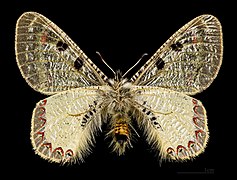Wrong Apollo
| Wrong Apollo | ||||||||||
|---|---|---|---|---|---|---|---|---|---|---|

False Apollo ( Archon apollinus ) |
||||||||||
| Systematics | ||||||||||
|
||||||||||
| Scientific name | ||||||||||
| Archon apollinus | ||||||||||
| ( Autumn , 1798) |
The False Apollo ( Archon apollinus ), sometimes also called Osterluzei-Apollo or Greek Apollo , is a butterfly from the family of the knightly butterflies (Papilionidae).
As the German name “Falscher Apollo” already expresses, the part of the name “Apollo” is misleading, because taxonomically the species does not belong to the Apollo butterflies (genus Parnassius ), but to the genus Archon . In appearance, however, butterflies and caterpillars resemble many Apollo butterfly species.
features
butterfly
The wingspan of the moth is about 54 to 60 millimeters. The basic color of all wings is usually white-gray to milky white and more or less dusty gray. Since the scales are relatively thin, the wings often appear parchment-like in specimens that have been flown for longer. On the forewings, two broad, black, black webs running from the front edge to almost the middle stand out clearly. The submarginal area is slightly darkened and sometimes has a few weak reddish spots on the inside. There are black, red and blue dots of varying intensity on the edge of the hind wings.
Caterpillar
Adult caterpillars are cylindrical and blackish in color. Typical are four rows of round, red spots along the entire length of the body. Sometimes there are also some white spots underneath.
Similar species
The moths of the very similar but somewhat smaller species Archon apollinaris , which occurs in eastern Anatolia and even further east, can only be clearly identified by means of a genital morphological examination.
The caterpillars of the Red Apollo ( Parnassius apollo ) differ in that they only show two rows of red spots and they completely lack the white spots.
distribution and habitat
The spread of the False Apollo includes parts of Bulgaria , Greece , Turkey , Israel , Syria , Jordan , Lebanon as well as Iran and Iraq . The species prefers to colonize olive groves, vineyards, rocky slopes and forest edges.
Way of life
The main flight time of the univoltine moths are the months of March and April. The caterpillars feed on various types of pipe flowers ( Aristolochia ). Younger caterpillars live socially and protect themselves with a leaf spun with silk threads. The adult animals pupate in a light web on the ground in late summer. The pupa hibernates.
Subspecies
After genital morphological investigations, de Freina divided the species into several subspecies in 1985 , the majority of which are found in Turkey.
- Archon apollinus amasina
- Archon apollinus apollinus
- Archon apollinus drusica
- Archon apollinus forsteri
- Archon apollinus nikodemusi
swell
Individual evidence
- ↑ Tom Tolman, Richard Lewington: The butterflies of Europe and Northwest Africa , Franckh-Kosmos Verlags-GmbH & Co, Stuttgart 1998, ISBN 3-440-07573-7
- ↑ Josef J. de Freina: Revision of the genus Archon Hübner 1822 with information on the biology, distribution, morphology and systematics of Archon apollinus (autumn 1798) and Archon apollinaris Staudinger [1892] 1891 (stat. Nov.) (Lepidoptera, Papilionidae). Nota Lepidopterologicae 8, 1985
- ↑ Gerhard Hesselbarth, Harry van Oorschot, Sigbert Wagener, Die Tagfalter der Turkey , Vol. 1, Bocholt, self-published by Sigbert Wagener, 1995
literature
- Tom Tolman, Richard Lewington: The butterflies of Europe and Northwest Africa , Franckh-Kosmos Verlags-GmbH & Co, Stuttgart 1998, ISBN 3-440-07573-7
Web links
- Lepiforum e. V. Taxonomy and Photos
- www.schmetterling-raupe.de Photos
- www.pyrgus.de Butterflies and their ecology
- www.lepidoptera.pl Occurrence in Europe
- www.nic.funet.fi dissemination
- Archon apollinus at Fauna Europaea. Retrieved December 28, 2012
- Archon apollinus inthe IUCN 2013 Red List of Endangered Species . Posted by: Gimenez Dixon, M., 1996. Retrieved February 19, 2014.




